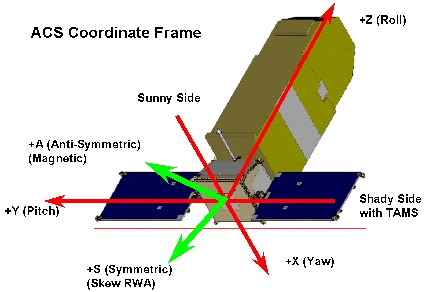

Mission Status Report #55 Star Date: February 15, 2002
The New FUSE Mission!Caption: FUSE Science Operations were on hold from Dec. 10, 2001, to approximately the end of January 2002, while we recovered from a problem with our pointing system. Since that time, we have been back in a limited science operations mode as we test out our new mode of pointing the satellite. The "New FUSE" is back in business, and it is just a matter of time until we expect to have our full capability back! (Graphic of FUSE with coordinate axes, courtesy of Orbital Sciences Corporation.) (Click image above to see larger version.)
I am pleased to report that FUSE is back in science operations mode using a new control system. We have performed a number of tests so far, and FUSE's sensitivity and resolution are as good as ever. We are back in business! The anomaly we experienced on December 10, 2001, involved the Reaction Wheels, as described in a previous report. Since the last report (January 28), we have made great strides in understanding how to operate with the "New FUSE," and have even performed some observations of new science targets intermixed with the various tests we are doing. The diagram above shows schematically how the new FUSE works. Originally, we had reaction wheels that controlled our pointing around the red X, Y, and Z axes in the diagram. In a nutshell, the problem was that we only have two operational reaction wheels (Roll and Skew, where the Skew wheel was redundant and could control any of the other three directions, but only one at a time). Hence, we could only stabilize the satellite about two of three axes. What we have done is twofold: 1) We have adjusted the coordinate system of the satellite so that the Skew wheel controls a new axis (green "S" axis in diagram above), which is halfway between the old X and Y axes, and 2) We have adapted a separate component of the control system, the Magnetic Torquer Bars (MTBs) so that they can provide control on a third axis (green "A" axis in the diagram). Believe it or not, we are "pushing" and "pulling" against the earth's magnetic field to control the motion and pointing of the satellite in this third direction. Amazingly, we have been able to demonstrate pointing stability of about 0.6 - 0.7 arcseconds (an arcsecond is 1/3600th of a degree), which is within a factor of two of what it was previously, and is small enough to have no impact on the quality of the science data we obtain. (Yes, it even surprises US that we can do this at the required level!) This is a significant accomplishment since it was not a known option or backup to the reaction wheels; it has been developed from scratch. And this is much finer control than has ever been demonstrated using MTBs. Our only limitation is that our control ability on the magnetically-controlled axis is not as powerful as provided by the reaction wheels. It is like we have a "strong muscle" in two directions and a "weak muscle" in the third direction. In addition, the strength and direction of the earth's magnetic field varies as FUSE goes around its orbit, and so the strength of our weak muscle varies with time and with the direction we are pointing the satellite. This means that our ability to hold steady for science observations is a complicated function of time and look direction on the sky. Even more complicated is understanding when it is best to move from one place to another, because then even the direction we are pointing is not constant! We've learned a lot already, but these are the areas where most of our testing is concentrated now. We currently have capability over approximately half of the sky and we are convinced we can open this up significantly. With time and a bit more patience, we should be back into full-time science mode soon. We once again want to congratulate all of the fine engineers and scientists at Orbital Sciences Corporation and at Johns Hopkins, and our supporting staff at NASA-Goddard Space Flight Center, who have worked so hard to get us back to doing science.
Reported by: Bill Blair, Chief of Observatory Operations More information on Reaction Wheels
|
